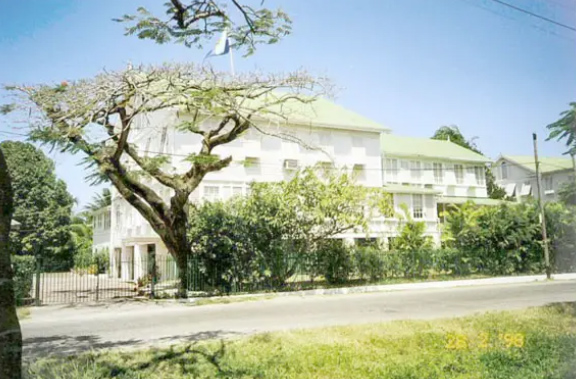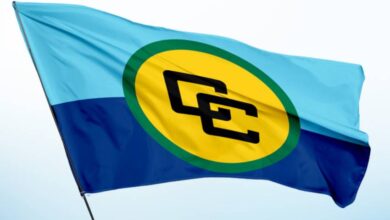
The sheer size of the imposing colonial structure at once impresses and intimidates. The Demerara shutters running around its perimeter, so typical of the architecture of that era, seem to be one of its most compelling features.
Pull Quote: `Everybody was glad to fit in because you thought you were building something.’
– Ms. Sheila Chan
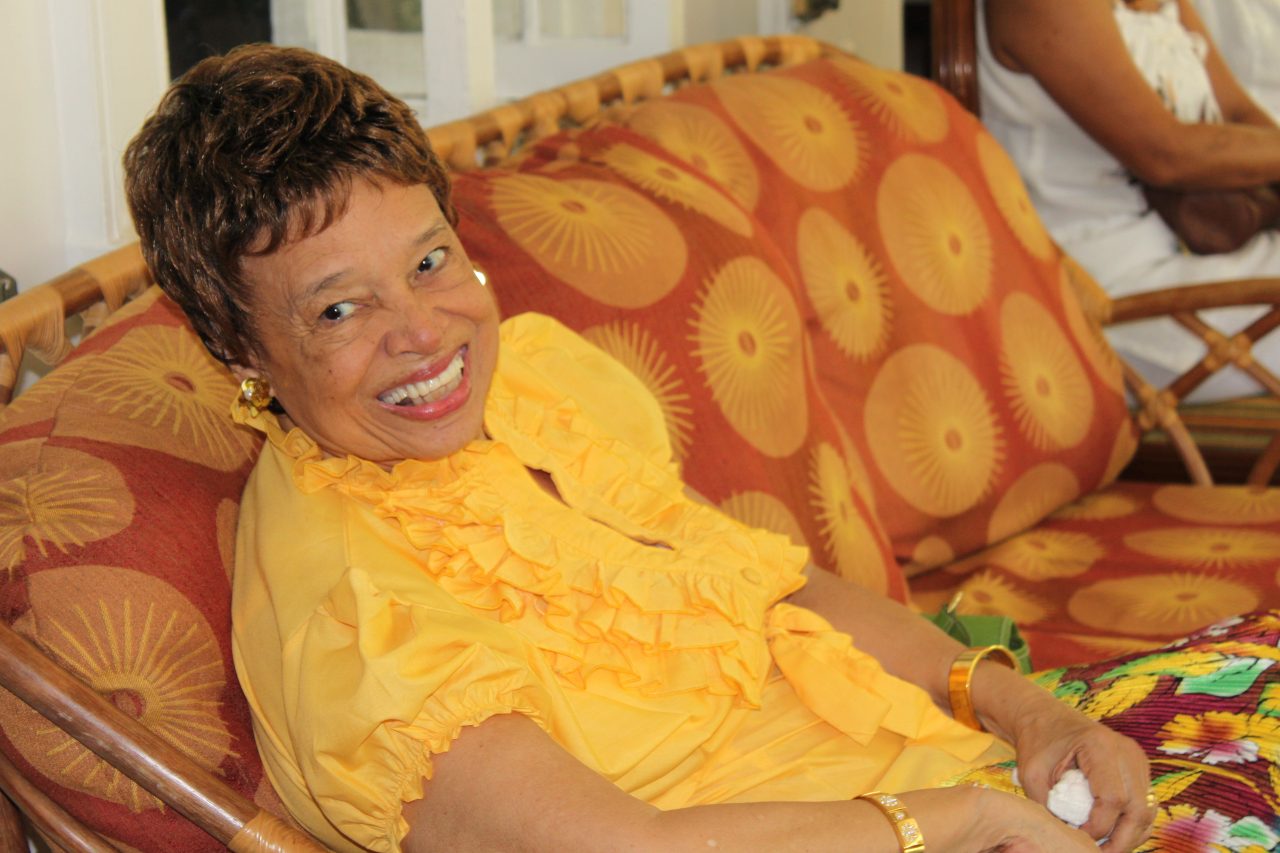
Overlooking the tree-lined avenue on Camp Street in Georgetown, Guyana, the magnificent, historic, wooden edifice is the place six Caribbean Community (CARICOM) Secretaries-General called home for a period of forty years.
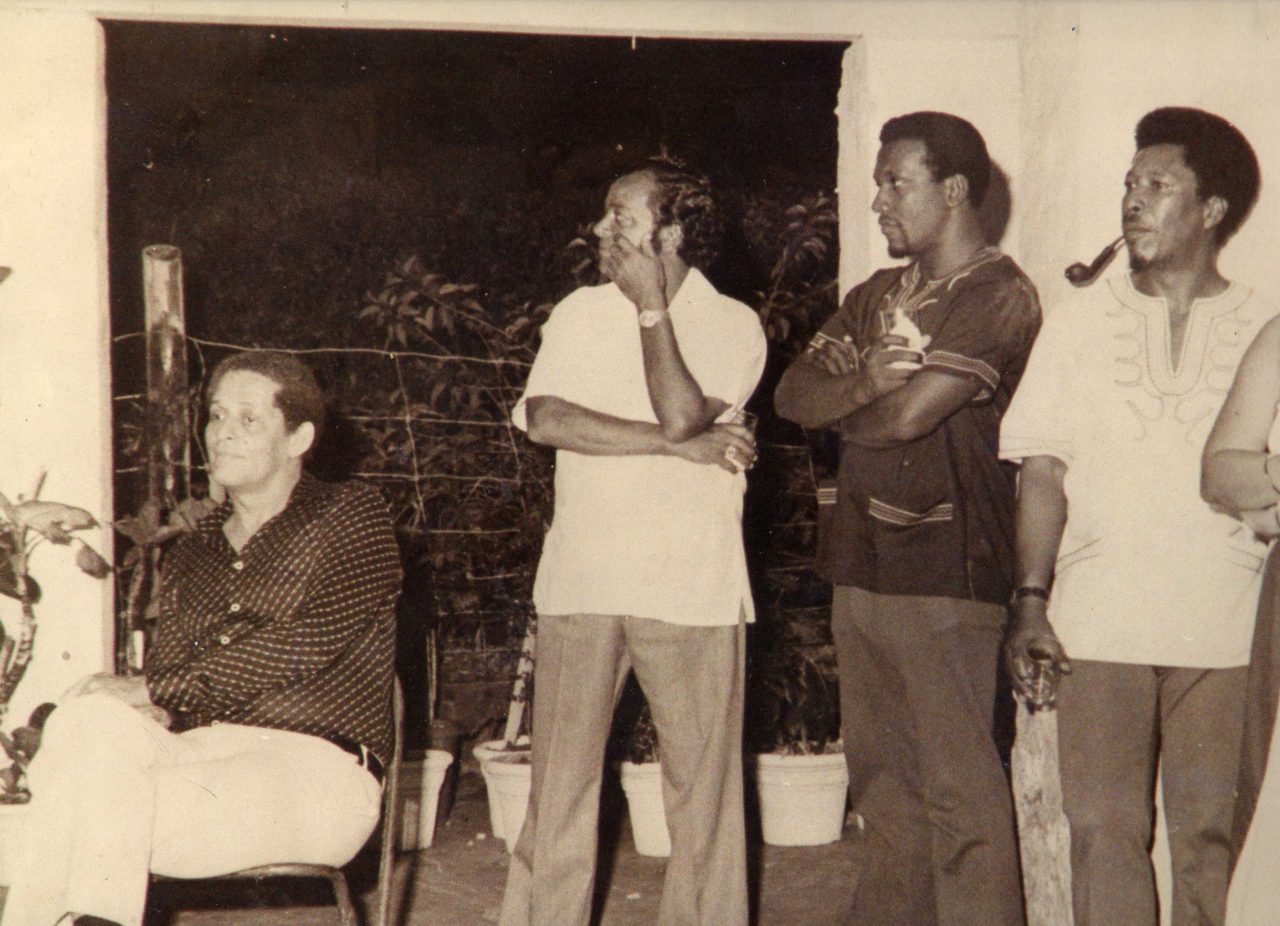
SG McIntyre, Sir Shridath Ramphal, Young Edwin Carrington and other guests at Colgrain House function 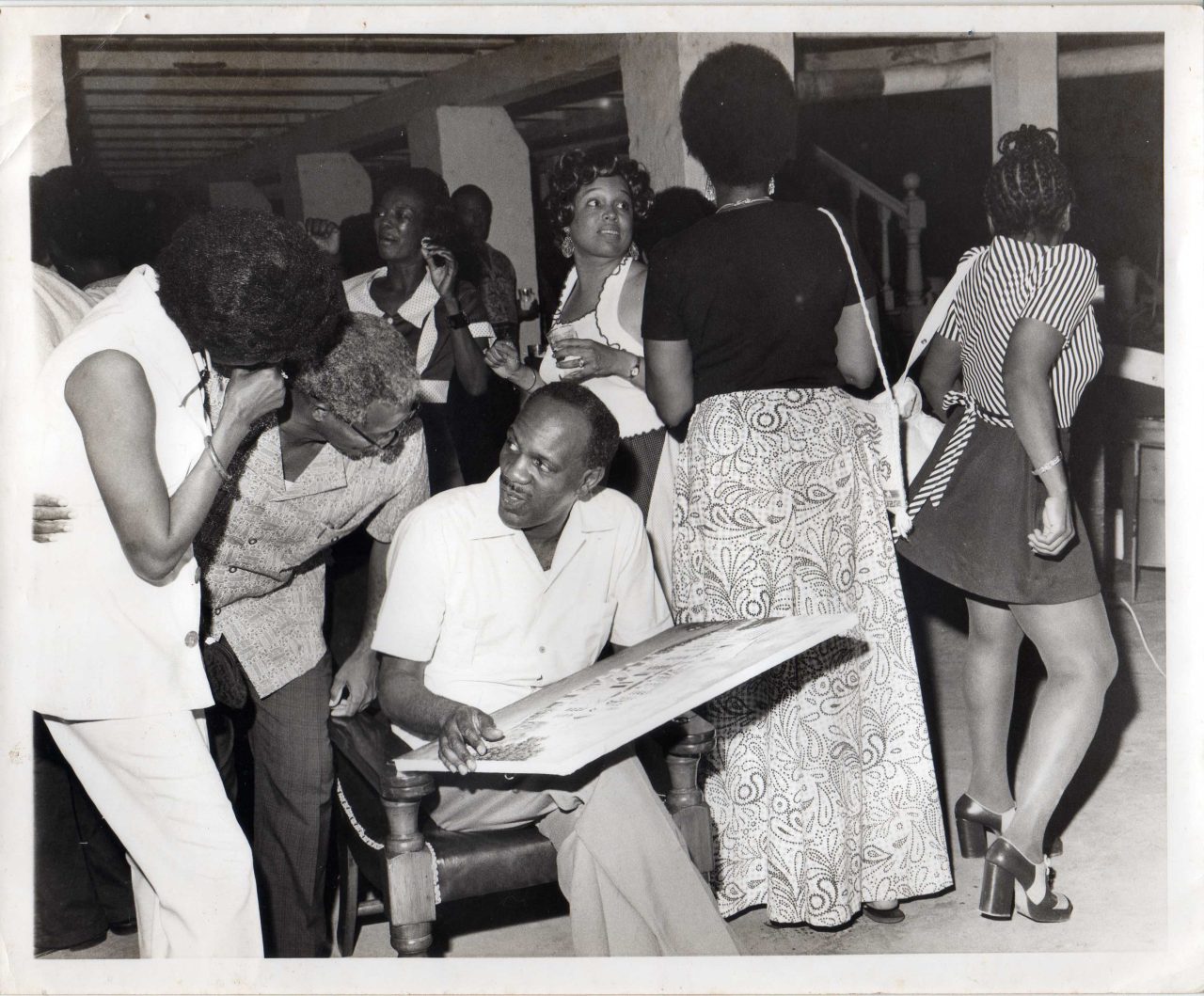
SSG Demas and guests at Colgrain House
Colgrain House, once the home of sugar magnate, Jock Campbell, has been an integral component of the regional integration movement from the Community’s inception. Back in July 1968, it housed both the administrative offices of the Caribbean Free Trade Area (CARIFTA) – the precursor to CARICOM – as well as the residence of its Secretary-General, Mr. Fred Cozier. From thereon, Secretaries-General William Demas, Alister McIntyre, Kurleigh King, Roderick Rainford, and Edwin Carrington, took up residence there.
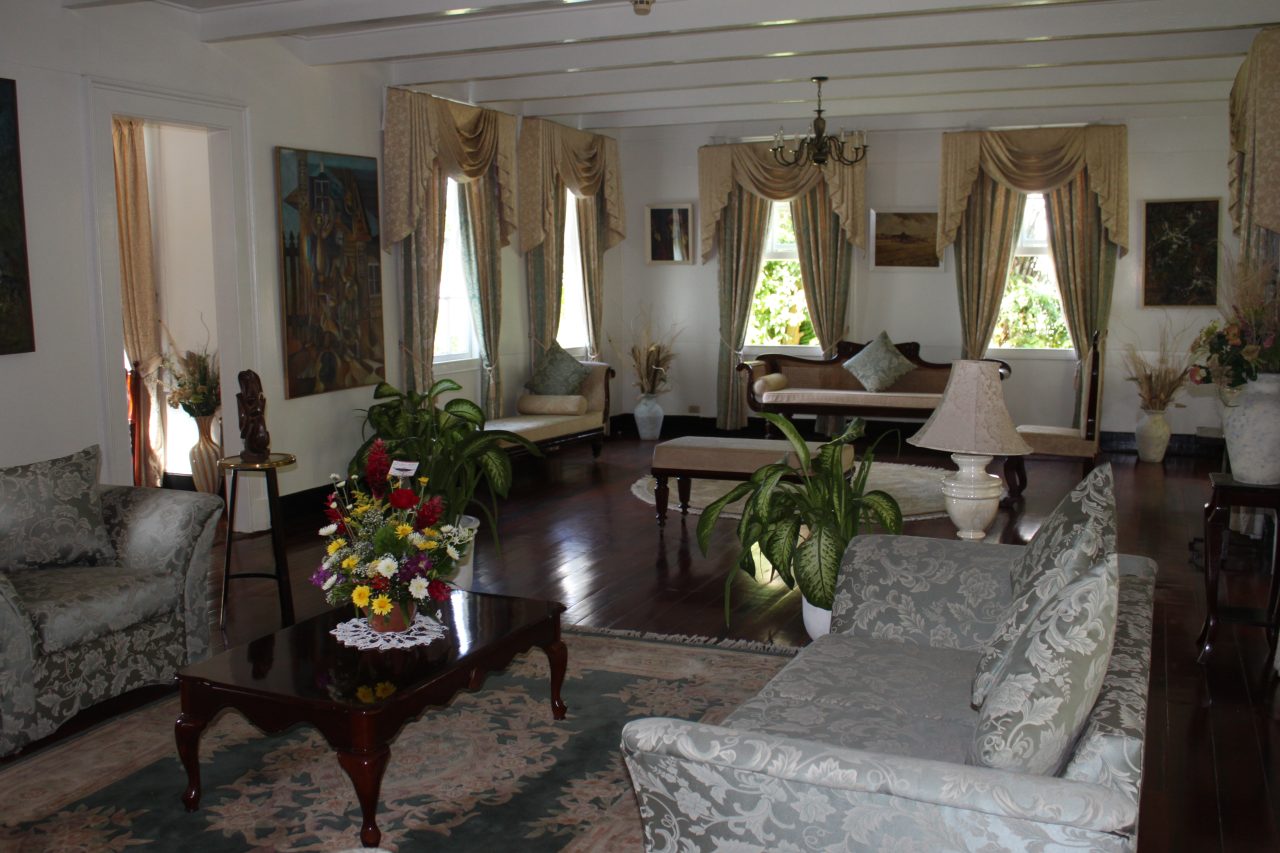
Mr. Cozier helmed the newly formed CARIFTA and its Secretariat, with a support staff of about four. He occupied the northern half of the building during his tenure, while the Secretariat was on the southern half.
“What I particularly enjoyed were the Demerara windows. I enjoyed opening up those windows upstairs and downstairs and having the benefit of the cool breeze blowing through the building. The only (problem) was closing them back up in the evenings!”
– Former Secretary-General Roderick Rainford
Taking a quick trip down memory lane, Ms. Sheila Chan, who, as Secretary to the Secretary-General was one of the first employees of the Secretariat, recalled that at that point in time, the other staffers were senior secretary Ms. Ruby Harry, and an office attendant.
“We were busy getting furniture for the office and busy getting other stuff, even though the premises were furnished for his residence. We had a lot of work to do to actually establish the thing,” with only three weeks until the formal opening of the Secretariat, Ms. Chan recalled.
She remembered Mr. Cozier being “well prepared” with all of his ordinances to establish the Secretariat.
“The Secretary-General, who was an extremely capable Administrator, soon had the Secretariat up and running. He established the policies under which the Secretariat would operate, for example, communication to Member States would be via Savingram; the Committees that should be established, and how often they should meet,” she said.
Very shortly after the Secretariat was established, Chief Economist, Mr. Joseph Tyndall, a Guyanese, and Chief Administrative Officer, Mr. Noel Venner, a Saint Lucian, joined the modest staff.
“It was a very tight ship because it was small. Everybody was glad to fit in because you thought you were building something,” Ms. Chan said, adding that one would never have imagined that the Secretariat would have grown to such large numbers. The Secretariat currently has a core staff of about 300 and is headquartered at Turkeyen, Greater Georgetown.
Guests who passed through Colgrain’s doors, she recounted, often described the building as an architectural wonder.
“It is a beautiful, sprawling building of Guyana’s woods and a multitude of windows to allow the Atlantic breezes to waft through and keep the place cool. It has extensive grounds where many a CARICOM `fete’ was held and a large swimming pool where the Secretary-General and his staff had many informal meetings while enjoying a well-deserved break. It was beautifully furnished with lots of antique furniture, and several masterpiece paintings adorned its walls,” Ms. Chan remembered of the home.
Ms. Chan, who retired from the Secretariat in 2008, said reflecting on Colgrain House in its “glory days, one can only be proud to be a Guyanese when one looks around and sees that Guyana kept its two promises to provide a residence worthy of a Secretary-General of an international organisation, and the Secretariat’s headquarters which can compare with any other elsewhere.”
Colgrain’s character
In an interview in 2012, Sir Alister McIntyre – who was Secretary-General from 1974-1977, and who died in 2019 – took that sentiment further; it was a very important gesture, he said, for the government to turn the house over to the Caribbean Community, and he regarded it as a symbol of CARICOM’s presence in Guyana and in the Region as a whole.
It was a great privilege, he said, to have lived in Colgrain House, because it was symbolic of the transfer of power in Guyana, from the companies to the government. “It was a manifestation,” he said, “of the fact that the government was the principal decision-maker in the country …”
The “character of the house” also left a great impression on the former Secretary-General. It was his view that the character had to be maintained.
“One of the things that distressed me back then were that houses of historic value were being torn down without a sense of preserving history,” he said.
He had a vivid recollection of the works of Caribbean art that were displayed there that gave it the Caribbean flavor.
“That was reflected in CARICOM itself, so I was very careful when I was there,” he recounted.
As a matter of fact, he was particularly concerned about the maintenance of the paintings so that “no deterioration would take place during my time there”.
So finicky was he about preserving the integrity of the historic building, that Sir Alister limited functions held there – “because of the inevitable damage that occurred” – to those that were directly associated with CARICOM. Some of those functions were lunches and cocktail receptions for ministers and delegates of meetings. International bars for charitable fundraising purposes, though not CARICOM-related, were also held there.
Hesitant about Colgrain
For Mr. Roderick Rainford, who, in 1983, became Secretary-General, Colgrain House held a special place in his heart as he tied the knot there in a small civil ceremony in 1992. By then, he had become accustomed to the sprawling, intimidating home he had moved into from his modest residence in New Providence on the East Bank of Demerara.
“When I became Secretary-General, I was hesitant to go to Colgrain House because of its size. It was huge! After I overcame that initial hesitation and moved in, I got around to enjoying it immensely,” he recounted with amusement, during an interview in 2012.
Giving an indication of the size of the property, Mr. Rainford recalled that the Secretary-General’s bedroom was a huge area that, in his estimation, could have been divided “into about three bedrooms”.
“What I particularly enjoyed were the Demerara windows. I enjoyed opening up those windows upstairs and downstairs and having the benefit of the cool breeze blowing through the building. The only (problem) was closing them back up in the evenings! I used to enjoy the nice, long veranda facing Camp Street,” Mr. Rainford recalled of his time at Colgrain.
The Demerara shutters, he said, were a “fantastic Guyanese invention” and it would be a pity if the “charming structures were replaced by concrete boxes”.
He took pride in ushering visitors – among them Heads of State – around the home, and showing off its collection of paintings.
“It was always enjoyable to take visitors around to show off the paintings. With the passing of the years and the weather some of the paintings were deteriorating and I had a competent artist retouch some of them to give them a new lease on life,” he said.
Mr. Rainford was also drawn to the grounds of Colgrain House. He planted and nurtured fruit trees there, among them two sapodilla trees. A self-confessed “great lover of sapodilla”, the former Secretary-General planted the trees after enjoying “some delicious sapodillas. They were so sweet that I put the seeds in some little pots, selected the best two and planted them.”
He remembered the mango trees that he found there and the avocado tree “at the foot of the stairs of the back entrance to Colgrain”.
“But there was a problem with that tree. Every year, it would blossom and bear, but the fruit would fall off while they were still young. An agronomist came and did something to it and forever after that, I was getting the most delicious pears. Whatever magic he worked, he fixed it!”
Like Ms. Chan, Mr. Rainford had fond memories of entertaining staff members and other guests at the official residence.
“There was a time when, as part of the practice of keeping in touch with the staff, we would have open house, once each month on a Saturday afternoon, where all staff who wished to, attended. We divided the staff into four and had open house for a quarter of the staff so that by the end of the year, all staff members would have had the chance to come to the social gathering… Anita used to cook some delicious cook-up, with chicken. A good number would turn up. I suppose those who didn’t come were those who were quarrelling with the Secretary-General. There was the time too when, after each Heads of Government Meeting, the press would come to Colgrain House for a post-Heads of Government press conference. It was a good gathering.”
Colgrain House was also open to guests for the traditional CARICOM Day reception.
“Since we were normally out of Guyana, we would have the CARICOM Day reception not on the Fourth of July, but the first available opportunity after the Heads of Government Meeting,” he recalled.
Mr. Rainford also recalled that International Bars were among the events for which the premises were made available.
“St John’s Ambulance Brigade used to hold them. The Secretary-General would make the premises available for the holding of international bars. So he would simply make the premises available, then retreat into the upper echelons of the house and hide away until they were finished,” he said.
Air of calm and peacefulness
Other nuggets of information on Colgrain House came from longest serving Secretary-General, Sir Edwin Carrington who demitted office in December 2010. Sir Edwin moved from Herdmanston House into the official residence and lived there for eighteen and a half years.
He recalled that originally, there were two floors, one for the dining and sitting rooms and the other for the bedrooms. There were six rooms upstairs; one could have been a study rather than a bedroom. There were three bathrooms. Maid quarters were constructed on the ground floor and there were two security units.
“I liked the house. It was spacious; it had an air of calm and peacefulness. It was wooden and therefore didn’t have the type of concrete thing that is not particularly attractive to me. There were wooden windows, Demerara shutters,” he remembered.
According to Sir Edwin, Secretary-General William Demas told him there was a piece of furniture in the house where Jock Campbell was conceived.
For those who have had the good fortune of living and/or working at Colgrain house, the grandeur, historicity and symbolism are etched in their psyche. For them, the great house holds great memories. (Reprinted from CARICOM View Magazine, July 2013)
Colgrain House
Colgrain House is located in Camp Street, Georgetown. Its name is taken from the Scottish family estate of one of its former owners, Mr. Campbell. Built in the late 19th century, it can be described as a great house. In that era, it was the centre of high society gatherings.
Mr. Thomas Edward Jones of Riverside Wharf Company was one of the owners of the building in the 19th century. In October 1909, he sold it to La Penitence Estates of which Mr. Campbell was the senior partner. While it was in the possession of La Penitence Estates, M.B.G. Austin, son of Bishop William Austin and senior attorney of that firm, was one of its many occupants.
The building was sold several times and was acquired by Bookers Holdings in 1951. It was called `Booker House’ during this period. Subsequently, it was sold to the Federal Republic of Germany. Then, the Government of Guyana purchased the building in 1975. The building subsequently became the official residence of the CARICOM Secretary-General. (Information provided by the National Trust of Guyana)

